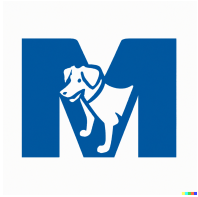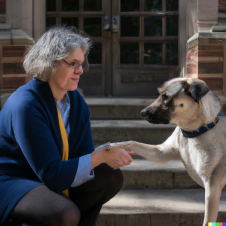EECS 442: Computer Vision Fall 2023
Hello, dear friend, you can consult us at any time if you have any questions, add WeChat: daixieit
EECS 442: Computer Vision
Fall 2023.
Problem Set 1: Image filtering
|
Posted: Monday, August 28, 2023 Due: Wednesday, September 13, 2023 For Problem 1.1, please submit your written solution to Gradescope as a .pdf file. For Problem 1.2, please submit your solution to Canvas as a notebook file ( .ipynb), containing the visualizations that we requested. Please also follow our instructions to convert the your Colab notebook to a PDF file and submit the PDF file to Gradescope. For your convenience, we have included the PDF conversion script at the end of the notebook. |
The starter code can be found at:
https://colab.research.google.com/drive/1hsE0fNNvYPbjAmkId5IVi2gWOcmsx9oW?usp=sharing
We recommend editing and running your code in Google Colab, although you are welcome to use your local machine instead.
Problem 1.0 numpy review (optional)
We will post a Colab notebook containing a brief introduction to numpy. If you are new to numpy and numerical computing, we encourage you to work through these examples. They should cover the background that you need to complete this problem set. The Colab notebook can be found at:
https://colab.research.google.com/drive/1f7nAcXVy7jgvt21LhP_dHSmM-ARqUXCD?usp=sharing
Problem 1.1 Properties of convolution
Recall that 1D convolution between two signals f, g ∈ RN is defined:

(a) Construct a matrix multiplication that produces the same result as a 1D convolution with a given filter. In other words, given a filter f, construct a matrix H such that f ∗ g = Hg for any input g. Here Hg denotes matrix multiplication between the matrix H and vector g (2 points).
(b) In class, we showed that convolution with a 2D Gaussian filter can be performed efficiently as a sequence of convolutions with 1D Gaussian filters. This idea also works with other kinds of filters. We say that a 2D filter F ∈ RN×N is separable if F = uv ⊤ for some u,v ∈ RN, i.e.
![]() F is the outer product of u and v. Show that if F is separable, then the 2D convolution G * F can be computed as a sequence of two one-dimensional convolutions (2 points).
F is the outer product of u and v. Show that if F is separable, then the 2D convolution G * F can be computed as a sequence of two one-dimensional convolutions (2 points).
(c) (optional) Show that convolution is commutative, i.e. f * g = g * f. You may assume circular padding (e.g., f[−1] = f[N − 1]), zero padding, or whatever is convenient. Note: we will not grade this problem, and you will not get bonus points for completing it.
Hint: Write the equation for f * g, and figure out how to “rename” the variable used in the summation to arrive at g * f.
(d) (optional) Show that convolution is associative, i.e. (f * g) * h = f * (g * h).
Note: One option is to define H in “bracket” notation using “...” symbols, e.g., H =
lN ![]() 1 N
1 N ![]() 2 ...(...) N1(−) 1]. Another option is to explicitly define the entries Hij .
2 ...(...) N1(−) 1]. Another option is to explicitly define the entries Hij .
Hint: Start by writing down the expression for G * F and then, inside the double summation, write F in terms of u and v.
(e) (optional) Show that cross-correlation,

is not commutative.
Problem 1.2 Sponsored problem: pet edge detection
As you know, this course is largely funded by grants from Petco, Inc.™ Unfortunately, one of the strings attached to this funding is that we must occasionally assign sponsored problems that cover topics with significant business implications for our sponsor1 . Our partners at Petco see an opportunity to use computer vision to pull ahead of their bitter rivals, Petsmart™ . Instead of painstakingly marking the edges of dogs and cats in pictures by hand—the current industry practice—they have turned to us for an automated solution.

Figure 1: The Petco / EECS 442 partnership, illus- trated with DALL-E 2.
(a) Using the starter code provided, apply the horizontal and vertical gradient filters [1 -1] and [1 − 1]⊤ to the picture of the provided pet producing filter responses Ix and Iy . Write a function convolve(im, h) that takes a grayscale image and a 2D filter as input, and returns the result after convolution. Please do not use any “black-box” filtering functions for this, such as the ones in scipy3 . You may use numpy.dot, but it is not

Figure 3: (a) A pet photo helpfully delivered by our sponsor, (b) a failure case for a simple edge detector. These images are provided in the starter code. Photo credits can be found here.
necessary. Instead, implement the convolution as a series of nested for loops. Compute the
edge strength as Ix(2) + Iy(2) . After that, create visualizations of Ix , Iy, and the edge strength,
following the sample code.
The filter response that your function returns should be the same dimensions as the input image. Please use zero padding, i.e. assume that out-of-bounds pixels in the image are zero. Also please make sure to implement convolution, not cross-correlation. Note that this simple filtering method will have a fairly high error rate — there will be true object boundaries it misses and spurious edges that it erroneously detects. The team at Petco, thankfully, has volunteered to painstakingly fix any errors by hand (3 points).

Figure 2: A meeting between the provost and a Petco representative, made using DALL-E 2.
(b) (Optional) This method detects edges fairly well on one of the dogs, but not the other. Our sponsor would like us to investigate why this is happening. First, convert your gradient outputs to edge detections using a hand-chosen threshold τ (i.e. set values at most τ to 0 and those above to 1). Point out 2 errors in the resulting edge map — that is, edge detections that do not correspond to the boundary of an object — and explain what causes these errors.
(c) While the edge detector you submitted works well on some pets, engineers are reporting a large number of failures, and Petco higher ups are not happy. Rumor is that it’s failing on pets that are playing in grass, especially for dogs with fluffy coats, such as “doodle” mixes — a particularly lucrative market for our sponsor (Figure 3b). It appears that the gradient filter is firing on small, spurious edges.
Kindly address our funders’ problem by creating an edge detector that only responds to edges at larger spatial scales. Do this by first blurring the image with a Gaussian filter, before computing gradients. Implement your Gaussian filter on your own4 . Please do not use any “black-box” Gaussian filter function for this, such as scipy.ndimage.gaussian filter![]() .
.
Apply both the Gaussian filter and the gradient filter using a black-box convolution function scipy.ndimage.convolve on the image, rather than your hand-crafted solution.
(i) Compute the edges without blurring, so we can look at the before-and-after results.
(ii) Compute the blurred image using σ = 2 and an 11 × 11 Gaussian filter.
(iii) Instead of blurring the image with a Gaussian filter, use a box filter (i.e., set each of the
11 × 11 filter values to 1/112).
(iv) Compute edges on the two blurred images.
(v) (Optional) Do you see artifacts in the box-filtered result? Describe how the two results differ. Include your written response in the notebook.
Visualize the edges in the same manner as Problem 1.2(a). Your notebook should contain edges that were computed using no blurring, Gaussian blurring, and box filtering. Please also show the two blurred images (2 points).
(d) Instead of convolving the image with two filters to compute Ix (i.e. a Gaussian blur followed by a gradient), create a single filter Gx that yields the same response. You can reuse the function in part (c). Visualize this filter using the provided code (2 points).

Figure 4: A member of our dog- based GPU delivery fleet, made us- ing DALL-E 2.
(e) Good news. Petco execs are pleased with your work and have renewed our funding for several more problem sets. At our last grant meeting, however, they made an additional request. Their competitors at Petsmart have hired a team of computer vision researchers and are now computing oriented edges of their pets: rather than just estimating just the horizontal or the vertical gradients, they now provide gradients for an arbitrary angle θ . Petsmart’s method for doing this, however, is computationally expensive: they construct a new filter for each angle, and filter the image with it. Petco sees an opportunity to pull ahead of their rivals, using the class’s knowledge of steerable filters.
Write a function oriented grad(Ix, Iy, θ) that returns the image gradient steered in the direction θ, given the horizontal and vertical gradients Ix and Iy. Use this function to compute your gradients on a blurred version of the input image at θ ∈ { 1/4 π, 1/2 π, 3/4 π}, using the same Gaussian blur kernel as (c). Visualize these results in the same manner as the gradients in Problem 1.2 (a) (2 points).
2023-09-05